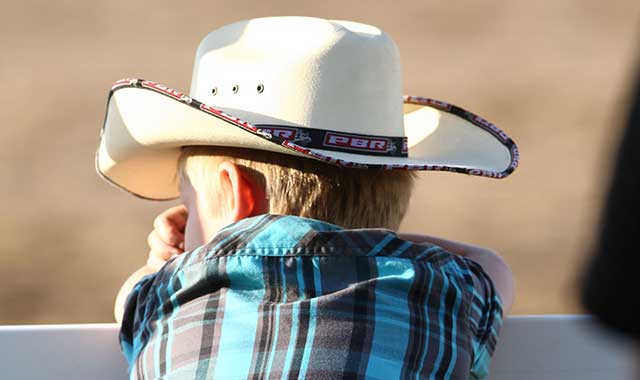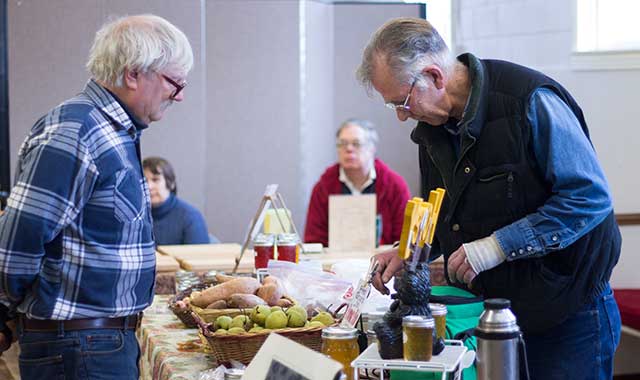Sure, some parts of our region look a lot like suburbia, but don’t be fooled, agricultural pursuits and the rural lifestyle are still thoroughly ingrained in our culture. Rhonda Mix looks at the enduring significance of the fair.

County fairs have been an integral part of our nation’s culture for more than two centuries.
Each year, more than 3,200 fairs are celebrated in North America, each sharing one common thread: deep ties to agriculture. After all, it’s because of agriculture that the county fair came to be.
The first fair is said to have taken place in 1811, when New England farmer Elkanah Watson organized the Berkshire Agricultural Society and held a cattle show in Pittsfield, Mass.
Inside this cattle show, livestock were on display as farmers competed in a showcase of the area’s best oxen, cattle, swine and sheep. Prize money was given away to the best contenders.
According to the International Association of Fairs & Expositions, Watson helped communities to organize their own agricultural societies and fairs for a number of years. He worked so diligently that, by 1819, a good portion of counties across New England had organized their own agricultural societies and events.
The fair soon spread to other parts of the country, and historians believe that, by the close of the 19th century, almost every state and province had one or more agricultural fairs or exhibitions.
The 20th century brought a steady migration of people from farms to cities, and eventually, county fairs became synonymous with fresh farm food, farm animals and country living.
With Chicago’s urbanization, Cook County’s fair ended for good after World War II. But fairs and farm life are still going strong in nearby counties, although fairs have evolved with a changing audience and the encroachment of suburban development into rural lands.
Even though DuPage and Cook counties each have fewer than 100 farms and less than 5 percent farmland, nearly 98 percent of the land in nearby DeKalb County is dedicated to farming, according to a 2012 census by the U.S. Department of Agriculture.
Interest in agricultural pursuits, it seems, has waned, and yet the county fair is alive and well, providing some of the biggest celebrations of the summer and an important reminder of the continuing role of farming.
You’ll still see plenty of livestock and tractors at county fairs in every corner of Northwest Chicagoland, where country life takes center stage.
McHenry County Fair
Since 1949, the McHenry County Fairgrounds in Woodstock have hosted the annual county fair, which happens this year from Aug. 5-9. It’s now a major attraction that’s owned and funded by the nonprofit McHenry County Fair Association.
Next to DeKalb County, McHenry County is the most rural in northwest Chicagoland, with nearly 60 percent of its land used for farms. Residents here haven’t forgotten their agricultural roots, and their festival schedule still revolves around 4-H shows and auctions. The county’s 4-H club is part of a national network of clubs aimed at empowering young people, primarily through agricultural and farming education.
Youngsters have long displayed the livestock they raise, but as McHenry County changes, so too has the 4-H format. This year’s shows go well beyond animals.
“We started out with the livestock shows, and, as we have expanded over the years, we also have brought things in such as large grandstand events,” says Liz Woolridge, McHenry County Fair office manager. “But our heart and soul still revolve around agriculture.”
The fun starts with the “Barnyard Buddies” expo. Introduced a few years ago, the program enables children to be farmers for a day, as they learn about fruits and vegetables, observe chicks in incubators and explore the realities of farm life.
A fair staple is the McHenry County Queen Pageant, where young ladies between the ages of 16 and 21 compete for the coveted title of Miss McHenry County.
Popular events also include the Broken Horn Rodeo, traditional tractor pulls, the Demolition Derby and, of course, the carnival rides provided by Skinner Amusements – all attractions which have helped modernize the fair in recent years.
Meanwhile, families can enjoy the annual talent contest and entertainment by the Loghoggers, chainsaw artists who carve logs and share their artistic creations, which are later auctioned off.
Times may be changing, but Woolridge believes the county fair will remain a tradition in Woodstock for years to come.
“It’s getting to be difficult for the agricultural communities, as there are fewer of them around,” she says. “There are not as many communities trying to find that tie to agriculture. But we still have that tie to what originally made the fair. We definitely have the feel of fun in what we now have to offer as a whole for the fair, but it’s still important that people come to learn about agriculture and the food-to-table process.”
Kane County Fair
One of the oldest fairs in Illinois, the Kane County Fair celebrates its 147th anniversary from July 15-19 at its St. Charles home.
“We started out like all county fairs – strictly agricultural,” says Larry Breon, fair president. “That’s what fairs were for. Fairs were there so people in rural areas could come and see the new gadgets related to farming, meet with farm and home advisors, and learn about things like canning and clothing technology. Back in the history of the Kane County Fair, those subjects were very important.”
But times are changing in Kane County, where little more than half of the county’s landmass is used for farming. This year’s fair is a blend of rural traditions and modern attractions.
One tradition that hasn’t changed is the Swifty Swine pig races, which began 40 years ago. Four times a day, these pigs race around a track for a reward of Oreo cookies.
“The races have been a staple of the fair for years,” says Breon. “There’s a new batch of young people coming out and seeing the pig races for the first time, and they really enjoy it. It’s just a fun event that children get a kick out of. ”
Also returning to the fair this year is the Smash ‘Em Bash ‘Em Demolition Derby, a longtime favorite.
“People like to see cars getting smashed up, so long as it’s not their own car,” says Breon with a laugh.
Visitors can also catch the Professional Championship Bullriding show, which is covered by the Entertainment and Sports Programming Network.
Entertainment aside, one of the most important events at the fair continues to be the 4-H shows, which include farm animal displays of poultry, swine, cows and horses, as well as presentations of photography and home economics creations.
“There may be a lot of festivals in our area throughout the year, but the one thing the fair does differently is it gives the 4-H kids a chance to exhibit,” says Breon.
“I think it’s important to give young people this opportunity to see and participate. The spirit of the fair is still about friendly competition and, in 4-H, for young people to meet others their own age. And even though a young person may want to win a competition, at the end of it all, they learn you can still go out with your competitors and have ice cream together anyway.”
Suburban growth around Kane County has forced the fair to evolve, in some ways dramatically, says Breon. For example, farm machinery displays were once a centerpiece of the fair, but now they aren’t even on the schedule. Also gone are the days when the fairgrounds were full of dust and mud.
Today, the grounds have climate-controlled buildings and paved walkways. In 2008, the 32,000-square-foot Prairie Events Center was built to host fair exhibits and non-fair events, such as the monthly Kane County Flea Market. Modern improvements have helped to ensure a bright future for Kane County’s fair, says Breon.
“The expense of running a fair can be so great, and many fairs may not be able to continue in the future,” he says.
“Many fairs receive money from the Illinois Department of Agriculture, and with budgets being trimmed and extensions being cut back, it will hurt some fairs – probably mostly in central and southern counties.
“The next few years, I think, will be dramatic,” he adds. “I hope the fairs survive.”
Lake County Fair
Lake County’s first fair was held in 1851 in Antioch. At that time, its mission was to encourage farming and exhibit farm-related produce and animals, though the fair also featured entertainers and horse races. For the next century, it would change locations among several townships, eventually settling in Grayslake in 1954.
In 2008, the Lake County Fair Association settled into its current grounds, located on 165 acres in southeast Grayslake. There are plans to make the grounds a destination for year-round agricultural activities, such as housing live beehives, exhibiting gardens and hosting other agricultural showcases, says fair president John Maguire.
Agriculture is central to this annual county fair, held this year from July 29-Aug. 2. The most enduring traditions come with the 4-H livestock competitions.
“4-H still has a really strong presence at the Lake County Fair, with all its educational exhibits and hands-on displays,” Maguire says.
The local 4-H club teaches members skills and values in fields such as dog training, farm animal care, crafts and culinary arts.
“The members work hard all year round and then submit their projects for judging at the fair,” Maguire says.
The Lake County Farm Bureau also promotes education through its “Ag Adventure” activity, where kids can “get their hands dirty” while learning about farm life. The program provides a glimpse into farm life for kids of all ages, and participants can pretend to milk a cow, plant mock corn, make crafts and discover new skills related to agriculture.
The Ag Adventure is a prime experience for suburban children, who may not have grown up near a farm, to better understand the importance of agriculture in raising food, says Maguire.
“Our fair is located at the edge of suburbia,” he says. “We’re trying to preserve the rural character of the fair by introducing it to suburban visitors. We like to view ourselves as a link to yesteryear for our audience. The county fair used to be one big fair party. Now, we have to be creative and think of ways to appeal to a much broader audience. In the future, I think county fairs will become more and more relevant. People are interested in getting back to the earth and our roots. We have a story to tell about how we got here.”
But agriculture is just part of the festival schedule. Entertainment highlights include the professional Motocross show, traditional truck and tractor pulls, and the Demolition Derby, which this year has a special twist: school buses and trucks will join one night of the event, says Maguire. Crash Fest will take place on Sunday. The Pro Rodeo Stampede, presented by Big Hat Rodeo, happens on Saturday.
It’s no matter that just 10 percent of Lake County is still farmland. For those who live the country life, this is the perfect time of year to make a connection with suburban neighbors.
“Our fair is full of great entertainment and daily specials,” says Maguire. “It’s a great family experience.”




















































